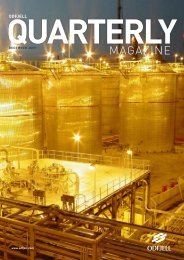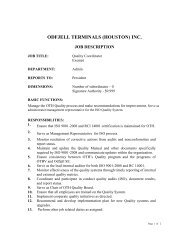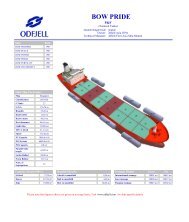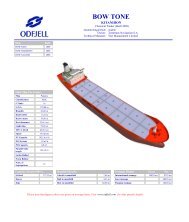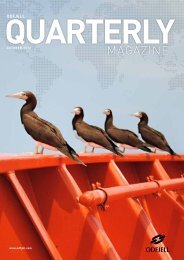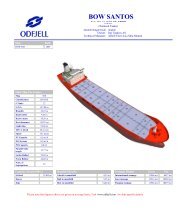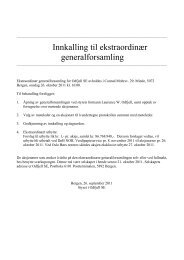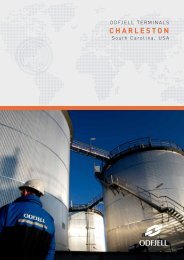Odfjell SE Annual Report 2012
Odfjell SE Annual Report 2012
Odfjell SE Annual Report 2012
Create successful ePaper yourself
Turn your PDF publications into a flip-book with our unique Google optimized e-Paper software.
odfjell group<br />
include cash in hand and in bank, deposits held<br />
at call with banks and other short-term highly<br />
liquid investments with maturities of three<br />
months or less from the date of acquisition.<br />
The amount of cash and cash equivalents<br />
in the cash flow statement does not include<br />
available credit facilities.<br />
2.20 Equity<br />
Paid in equity<br />
(i) Share capital<br />
The portion of the paid-in-capital equalling<br />
number of shares at their nominal value.<br />
(ii) Treasury shares<br />
The value of treasury shares’ portion of share<br />
capital.<br />
(iii) Share premium<br />
The excess value of the total paid-in-capital<br />
not reflected in the nominal value of the<br />
shares. Transaction costs of an equity<br />
transaction are accounted for as a deduction<br />
in share premium, net of any related income<br />
tax benefit.<br />
Other equity<br />
(i) Exchange rate differences<br />
Exchange rate differences arise in connection<br />
with currency differences when foreign<br />
entities are consolidated. When a foreign<br />
operation is sold, the accumulated exchange<br />
differences linked to the entity are reversed<br />
and appear in the net result in the same<br />
period as the gain or loss on the sale is<br />
recognised.<br />
(ii) Fair value and other reserves<br />
The fair value and other reserves include<br />
the total net change in the fair value of the<br />
cash flow hedge and financial investments<br />
available for sale. When the hedged cash flow<br />
matures or is no longer expected to occur,<br />
the net change in fair value is included in<br />
net result. When financial investments are<br />
sold or impaired, the accumulated fair value<br />
adjustments in equity are included in the net<br />
result as gains and losses from financial<br />
investment.<br />
(iii) Retained earnings<br />
The net result attributable and available for<br />
distribution to the shareholders.<br />
Dividends are recorded as a deduction to<br />
other equity in the period in which they are<br />
approved by the shareholders.<br />
Dividend payments are limited to the<br />
regulations in the Norwegian Public Limited<br />
Company Act.<br />
2.21 Dismantling liabilities<br />
If there is legal or constructive obligation<br />
to dismantle a tank terminal at the<br />
end of its useful life, liabilities for future<br />
dismantling expenses are measured at net<br />
present values. The dismantling liability is<br />
capitalized in the asset value. The liabilities<br />
are regularly evaluated, and adjusted when<br />
there are material changes in interest rates,<br />
inflation or in other dismantling expenses.<br />
The adjustments are recognised as financial<br />
expenses.<br />
2.22 Interest bearing debt<br />
Interest bearing debt is classified as noncurrent<br />
liabilities and appears initially as<br />
the amount of proceeds received, net of<br />
transaction costs incurred. In subsequent<br />
periods, transaction costs are deferred and<br />
included in net result over the life of the<br />
underlying debt according to the effective<br />
interest method.<br />
Interest bearing debt is generally noncurrent<br />
liabilities, while instalments within<br />
the next 12 months are classified as current<br />
liabilities.<br />
Interest expenses are recognised as an<br />
expense using the effective interest rate<br />
method.<br />
2.23 Provisions<br />
Provisions are recognised when the Group<br />
has a present legal or constructive obligation<br />
as a result of past events, and it is probable<br />
that an outflow of resources will be required<br />
to settle the obligation. Provisions are based<br />
on best estimates. Provisions are reviewed<br />
on each balance sheet date and reflect the<br />
best estimate of the liability. If the effect of<br />
the time value of money is material, normally<br />
more than twelve months, provisions are<br />
discounted using a current pre tax rate that<br />
reflects the risks specific to the liability.<br />
Where discounting is used, the increase in<br />
the provision due to the passage of time is<br />
recognised as a finance expenses.<br />
2.24 Pension cost and liabilities<br />
The Group operates a number of pension<br />
plans in accordance with the local conditions<br />
and practices in the countries in which it<br />
operates. Such pension plans are defined<br />
benefit plans or contribution plans according<br />
to the customary pension plans prevailing in<br />
the country concerned.<br />
Defined benefit pension plans are pension<br />
plans with retirement, disability and<br />
termination income benefits. The retirement<br />
income benefits are generally a function<br />
of years of employment and final salary<br />
with the Company. Generally the schemes<br />
are funded through payments to insurance<br />
companies as determined by periodic actuarial<br />
calculations. The liability in respect of<br />
defined benefit pension plans is the present<br />
value of the defined benefit obligation at the<br />
balance sheet date less the fair value of<br />
plan assets, together with adjustments for<br />
actuarial gains/losses and past service cost.<br />
The net pension liability is calculated based<br />
on certain estimates with regards to interest<br />
rates, future salary adjustments etc. The<br />
estimates are based on historical experience<br />
and current market conditions. The cost of<br />
providing pensions is included in net result<br />
so as to spread the regular cost over the<br />
vesting period of the employees. The effect<br />
of changes in estimates exceeding 10% of<br />
the highest of pension liabilities and plan<br />
assets is accounted for. Such changes are<br />
amortised over the remaining vesting period.<br />
For defined contribution plans, contributions<br />
are paid to pension insurance plans.<br />
Once the contributions have been paid,<br />
there are no further payment obligations.<br />
Contributions to defined contribution plans<br />
are included in net result in the period to<br />
which the contributions relate.<br />
The Group may at any time make alterations<br />
to the terms and conditions of the pension<br />
scheme and undertake that they will inform<br />
the employees of any such changes.<br />
2.25 Earnings per share<br />
Basic earnings per share amounts are<br />
calculated by dividing net profit for the year<br />
attributable to ordinary equity holders of the<br />
parent company by the weighted average<br />
number of ordinary shares outstanding<br />
during the year.<br />
Diluted earnings per share amounts are calculated<br />
by dividing the net profit attributable<br />
to ordinary equity holders of the parent (after<br />
deducting interest on any dilutive instruments)<br />
by the weighted average number<br />
of ordinary shares outstanding during the<br />
year plus the weighted average number of<br />
ordinary shares that would be issued on<br />
the conversion of all the dilutive potential<br />
ordinary shares into ordinary shares.<br />
27<br />
odfjell annual report <strong>2012</strong>



